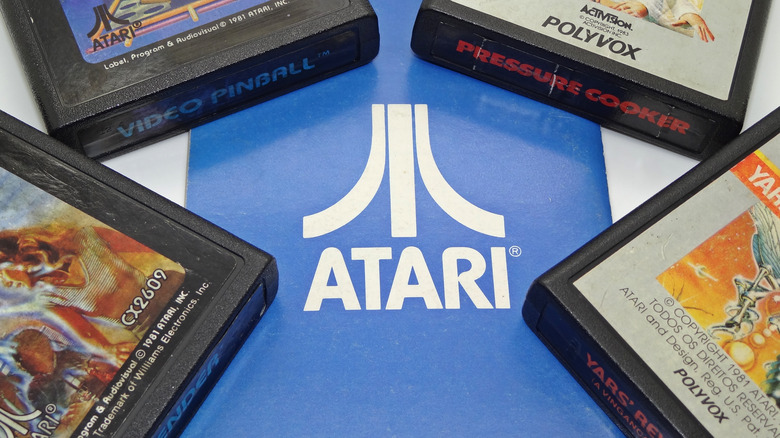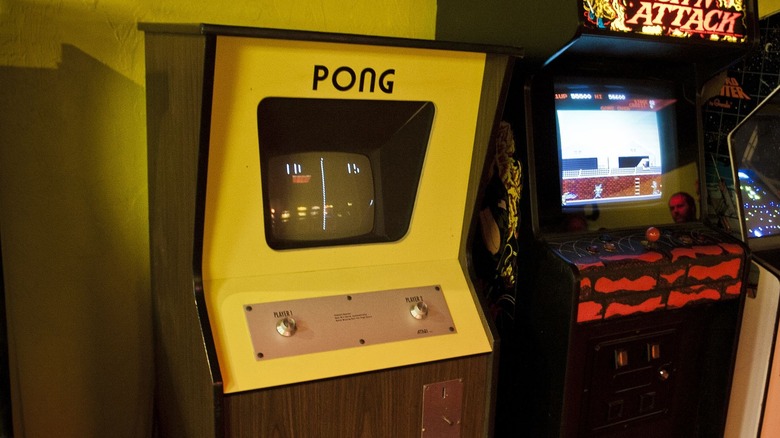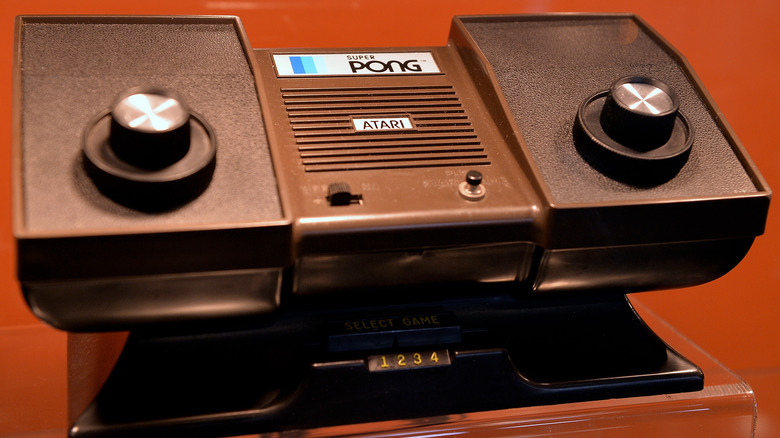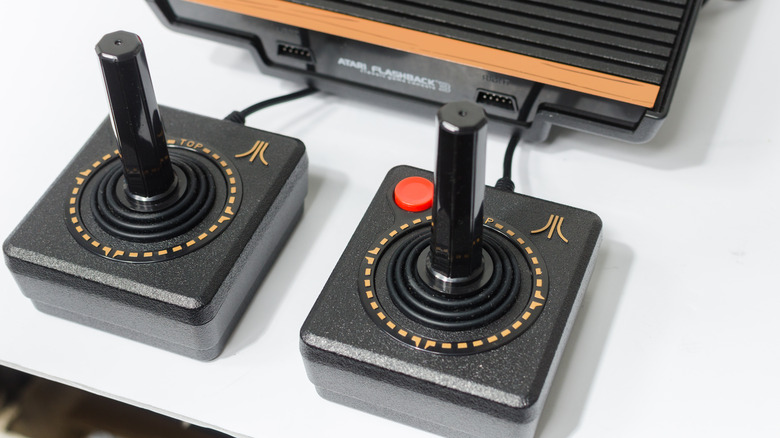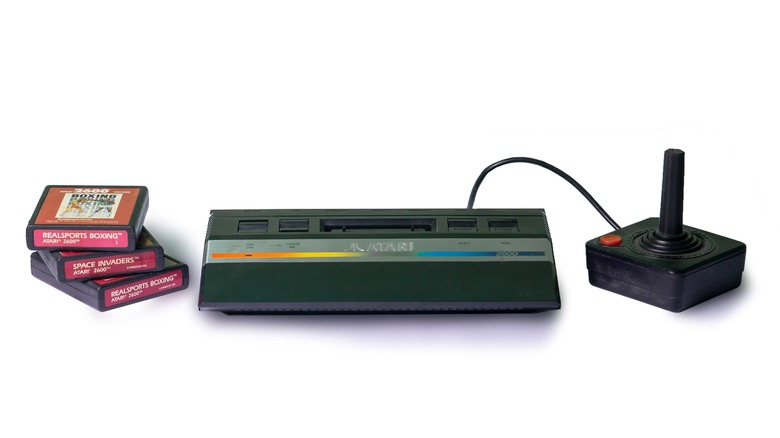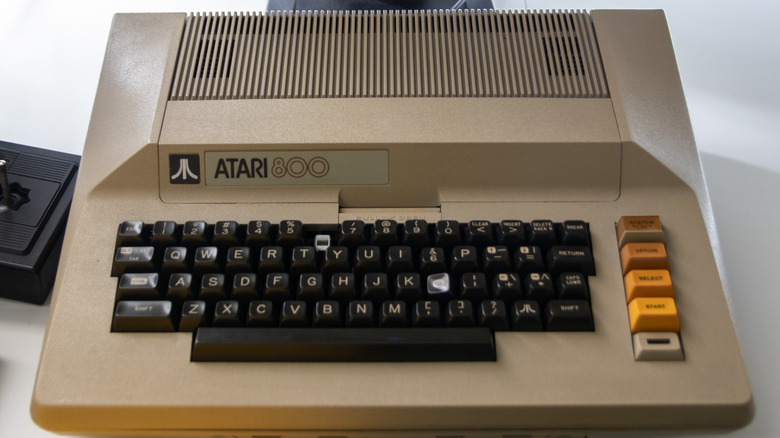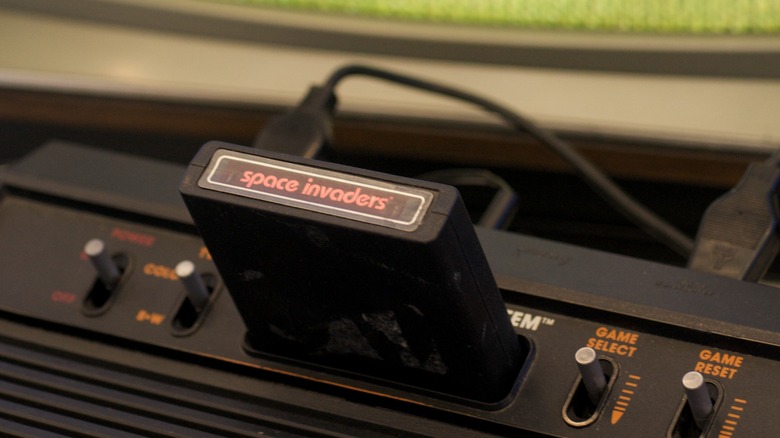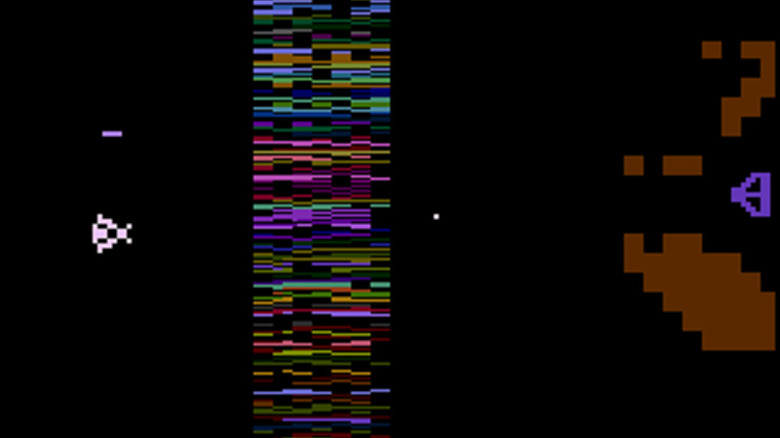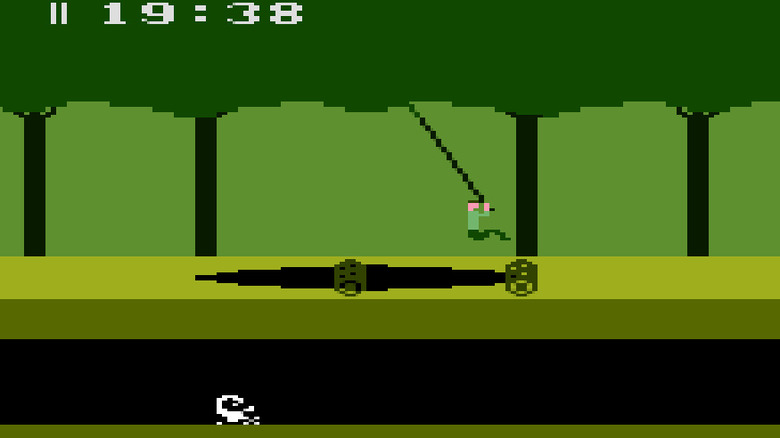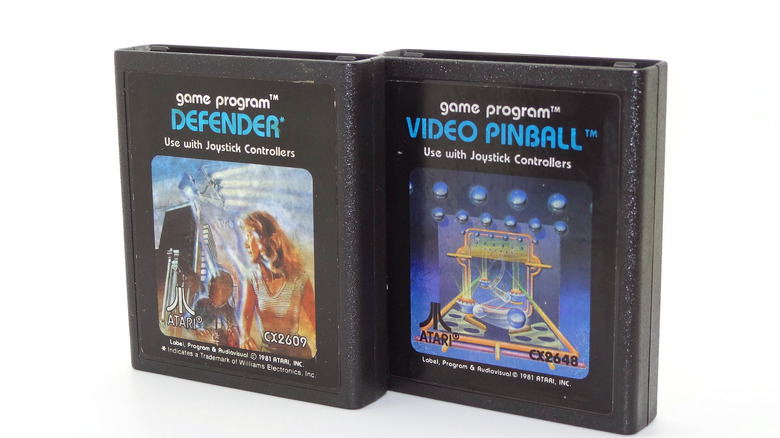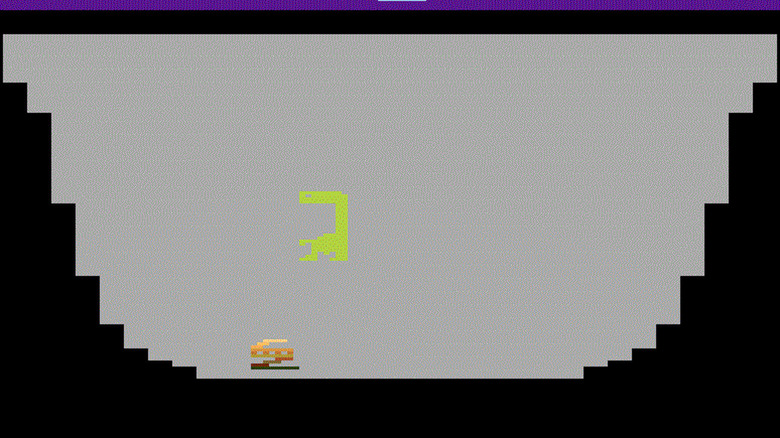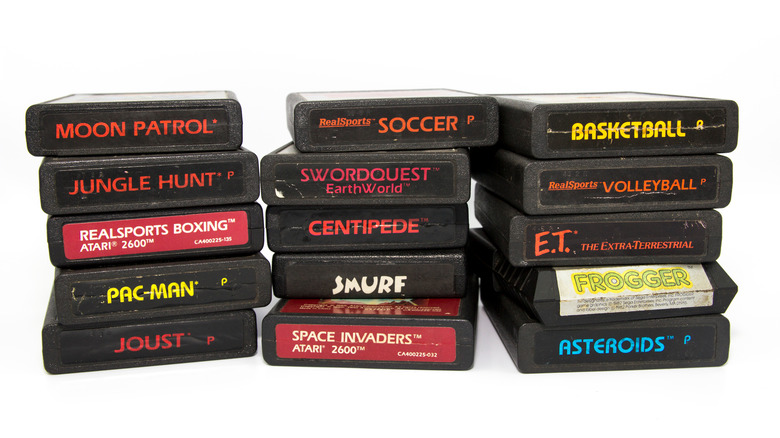The Rise And Fall Of Atari
Gaming systems are ubiquitous. A 2021 report from the Computer Technology Association showed that in 2021, 53% of American homes owned a video game console and 30% were planning to buy one within the year. There are several brands of consoles which, as shown by Statista, include Nintendo, PlayStation, and Xbox.
These three brands dominate the market today, but their existence was due to the groundbreaking work by Atari. Atari was the gaming innovator which created the industry as we know it. "Halo," "Zelda," "Minecraft," and "Grand Theft Auto" would not exist if not for the spadework done by Atari. In fact, it is no hyperbole to state that Atari at its peak was as dominant in the gaming industry as U.S. Steel was in the heyday of its 19th and early 20th-century monopoly.
So why isn't Atari listed next to PlayStation and Nintendo today? The answer is one of the most dramatic stories of meteoric ascent and catastrophic cratering in corporate history. Let's take a look at the rise and fall of Atari.
Atari was founded on $500
The story of Atari begins with Utah native Nolan Bushnell. While enrolled at the University of Utah's electrical engineering program, he was obsessed with playing an early video game named "Spacewar!." According to IGN, Bushnell would sneak into the computer lab to play on a computer that filled a room. But he also worked at an amusement park arcade that used coin-operated pinball machines and slot machines. It was this combination of analog gaming and computers that fueled, as described by MIT, Bushnell's inspiration. People may be willing to drop their coins to play video games. Together with software engineer Ted Dabney, they developed the first-ever coin-operated video game called "Computer Space."
While it was too complex to take off commercially, it did provide, as reported by "The Video Game Explosion," $500 in royalties for them to found Syzygy Co. in 1971. They changed the name to Atari the next year when they found Syzygy already in use. The name derives from the Japanese term "ataru" which means good fortune or that a good move is about to be made, such as checkmate in chess.
Atari's breakthrough would come in 1972 when Bushnell observed a demonstration of Magnavox's Odyssey console. The console, which had a variety of silent video games, featured one called "Table Tennis," which featured two rectangle players bouncing a square "ball" back and forth. This inspired Bushnell to hire engineer Al Alcorn, who never programmed a computer game before.
Pong hit the market like a missile
"Pong," according to IGN, was just meant to be a test project to hone engineer Al Alcorn's abilities. According to Wired, Nolan Bushnell made all the specifications and told Alcorn it was for a contract with GE (which it wasn't). Alcorn built the game, even adding sound. What truly differentiated "Pong" from other tennis-type games was that the ball sped up during play. The game was stuffed in a cabinet and made its debut during the summer of 1972 at a bar named Andy Capp in Sunnyvale, California. Within a week, the bar owner reported the machine had broken. When Bushnell examined it, it was because it was overstuffed with coins. "Pong" was an immense hit. Alcorn as quoted in Wired said, "We got hit in the a** by lightning with 'Pong.' Holey moley!"
Atari made immense profits off "Pong," and not just in quarters. To build the unit cost about $600, but they sold them for about $1,100. This allowed Atari to grow purely from its profits. "Pong" ended up not just in arcades and pool halls, but also in hotels and airports. Atari had inaugurated the video arcade industry.
Atari was sued for copyright infringement
Despite its financial success, not all was happy with Atari. Nolan Bushnell had alienated his partner Ted Dabney and as a result, he left Atari. For a long time, Dabney's role in Atari has been overlooked, but he was the one who invented the video positioning technology that made "Pong" possible.
Bushnell was not expecting the runaway success of "Pong," looking at it as a test. As quoted in Wired, Bushnell said, "It's like the movie 'The Producers,' you know? We're going to steal this idea from Magnavox, but it's a turkey so what's the problem? [But] all of a sudden it's a success." They produced home console versions that could be hooked up to televisions. The result was Magnavox suing Atari in 1974 for infringing on its patent. According to "Copy Game for High Score," it was the first video game lawsuit and involved not just Atari but other video game makers who ripped off Magnavox. They ended up settling out of court for some cash and for Atari to license the patent from Magnavox. This freed Atari to continue with other projects.
It was during this period that Atari hired a young Steve Jobs as a technician in his first job after college. According to Business Insider, he even pitched to Bushnell his idea to start up a personal computer firm. Bushnell declined, but he could have been a co-founder of Apple.
Bushnell sold out to Warner Communications
In 1976, Atari was bought by Warner Communications. The deal, which as reported by the New York Times, cost Warner $28 million. Of that $15 million was paid to Nolan Bushnell for his share of ownership. Why did Bushnell sell a company that he only founded four years earlier? According to "The Medium of the Video Game," Atari had just finished developing the Atari VCS (later renamed the Atari 2600) home gaming console. He wanted to produce enough units to bury what was quickly becoming a competitive field.
According to "Adventure: The Atari 2600 at the Dawn of Console Gaming," more competition was entering the field such as Nintendo and ColecoVision, and Atari was having cash flow problems trying to raise the funds necessary to mass-produce the equipment. Bushnell almost put the company up for public offering, but the market intimidated him. Instead, he managed to arrange the sale to Warner, which was a large conglomerate and had the capital heft Atari needed. As part of the deal, Bushnell remained head of the company, but he was ultimately working at Warner's pleasure.
Bushnell was sacked by Warner
Very quickly, the laid-back culture under Nolan Bushnell which supported the creative environment came under pressure from the new ownership. Slate reported that under Bushnell's ownership, the culture at Atari was freewheeling and hedonistic, featuring regular cannabis-laced parties complete with skinny dipping in hot tubs. Bushnell, as quoted in Slate, said, "We found out that our lifestyle and the parties were hugely good for attracting workers. If we were trying to hire somebody, we'd invite him to one of our parties." Nonconformity and creativity were valued above all else.
It is not surprising that after Warner took over Atari, Bushnell came to be increasingly at odds with the new ownership. Much of this, according to IGN, had to do with Warner's stuffy corporate culture versus Atari's licentious style. Inevitably, Bushnell became antagonistic to Warner.
Inc. reported that Warner had put up $120 million to develop and market the new Atari VCS. However, sales were slow, which led Emanuel Gerard of Warner — who originally brokered the Atari purchase — to propose a restructuring in 1978, where Bushnell would remain director, but he would be replaced as chairman. This led to an obscenity-strewn row between Bushnell and Gerard. Bushnell was dismissed shortly thereafter, but he became a legend in gaming history and went on to found, curiously enough, Chuck E. Cheese.
Corporate policies undermined Atari's creativity
When Nolan Bushnell left Atari, Warner Communications replaced him as CEO with Ray Kassar. According to a trade publication of the time, InfoWorld, the 50-year-old Kassar had spent most of his career with the textile company Burlington Industries. To bolster sales of the sagging Atari, he increased the marketing budget at the expense of research and development, according to IGN. This was intentional, since Kassar wanted to break the influence of the freewheeling software programmers under Bushnell. He also despised the culture Bushnell had created. Kassar once called Atari's programmers "high-strung prima donnas." This resulted in staff wearing t-shirts featuring an opera singer which read "I'm another high-strung prima donna from Atari." Critics condemned Kassar, claiming that he ruled Atari like an emperor and did not understand the business of computer gaming.
It is certainly true that Kassar fostered a toxic work environment. As told by "Moving Innovation," he was nicknamed "The Czar" Kassar and also called "Sock King" because of his previous career in the textile industry. As time passed, the core elements that had brought Atari its innovative greatness loathed the new management. As a result, in 1979, much of Atari's talent exited in droves.
Atari reached its peak with the Atari 2600
Curiously enough, the moment in Atari's history when it was at its most dysfunctional was also when it was most dominant. The company reached its peak from 1978 to 1982. In those years just after the ousting of Bushnell but before the weight of corporate strategy destroyed the business, Atari capitalized on sales of the Atari 2600, which had been developed in the Bushnell era.
As detailed by IEEE Spectrum, the Atari 2600 founded the entire home gaming industry. It was a unit that allowed cartridges with ROM software to be easily changed and used the television, through an adapter, to play those games. It was superior to a single home game version of "Pong" because the number of games the unit could play was limited to the processor and the imagination of gaming programmers. It was not the first console unit to have swappable cartridges for different games — that honor belongs, according to Wired, to 1976's Fairchild Video Entertainment System — but the Atari was the first to sell well. However, sales only exploded after 1980 when the company obtained the right to port a home version of the popular arcade game, "Space Invaders." This boosted sales which, according to IGN, reached two million consoles in 1980 and increased to 10 million in 1982. In that year, the revenue from Atari comprised 70% of Warner Communication's income. Computer gaming had exploded as a new industry.
Some of Atari's games are the most well-known in history
The games that Atari produced are well ingrained into the collective consciousness of Generation X. The first breakout was "Space Invaders," but as PC Magazine relates, there were many others. One breakout was, funnily enough, "Breakout," which, as told by the "A-Z of Atari 2600 Games," had been developed as an arcade game by Steve Jobs and Steve Wozniak. The release of 1979's "Adventure" featured three duck-like dragons, an arrow-shaped sword, and was the foundation of fantasy video gaming. That same year also featured a port of the popular arcade game "Asteroids." Atari also had a hit with another arcade port, "Missile Command," in 1981. Yet their weirdest hit was 1982's "Yars' Revenge" in which you played an alien type of bug who was trying to destroy the Qotile.
Then, of course, there was 1982's "Pac-Man" which sought to capitalize on the incredibly popular arcade game. According to "Vintage Games 2.0," the port itself was highly flawed and looked nothing like the arcade game, especially because the programmer was limited by hardware and given only six weeks to work on it. While the game sold millions based on the brand alone, the quality of the game besmirched Atari's reputation.
Atari exiles went to found new companies
The toxic work environment at Atari led to an exodus of programmers. The most prominent example of this involved Atari programmers Bob Whitehead, David Crane, Alan Miller, and Larry Kaplan. According to Game Informer, a marketing memo had circulated to the programmers in 1979 which showed which Atari games were the bestselling ones. The idea was to motivate the programmers to develop similar games. The four men noticed that the best-selling games were the ones they had developed. Because the revenues that were made off their games were so high, they felt mistreated. They went to Ray Kassar and demanded that they be treated like artists such as musicians and be given royalties. In a 1983 interview in Infoworld, Kaplan claimed that Kassar dismissed them calling them "towel designers." Kaplan also said Kassar stated, "I've dealt with your kind before. You're a dime a dozen. You're not unique. Anybody can do a cartridge."
As a result, the four men left and went on to found Activision ... so Atari attempted to sue Activision. It threatened retailers who dared to carry Activision titles. Yet the effort failed and instead a settlement was reached where Activision would pay royalties to Atari. The company went on to produce very popular games for the Atari 2600 including "Kaboom!," "Chopper Command," and "Pitfall!" (This last title incidentally also had a commercial featuring a young Jack Black.)
However, this meant that other companies could now make cartridges for the Atari platform. The floodgates were open.
Bad Atari games entered the market
Since other companies could now produce games for the Atari 2600, they began to inundate the market with games of dubious quality. For example, Funvision's 1982 title "Karate," which featured blocky fighters duking it out, was hardly "Mortal Kombat." The "A-Z of Atari 2600 Games" described it as "utterly atrocious" and one of the worst Atari games. A more middling, but typical lackluster title from a third party is TigerVision's 1982 title, "King Kong," which was essentially a "Donkey Kong" ripoff.
Some games as mentioned by "The Golden Age of Video Games," were just plain offensive, particularly those produced by Mystique, which were the first video games to be pornographic. Their titles included the highly offensive "Custer's Revenge," which, as described by "American West," entailed a reincarnated George Armstrong Custer seeking vengeance on the Sioux by avoiding arrows and assaulting women. Then there was "Beat 'Em and Eat 'Em," which, according to "Classic Home Video Games," was a pornographic version of "Kaboom!." Atari sued them and others for befouling their reputation. It is unclear what the result of the litigation was, but it is clear that the Atari brand was being pulled into the sewer.
Atari really jumped the shark with E.T.
Atari also produced its own inferior products. Of course, there was the hideous rendition of "Pac-Man," but at least in that instance, they were porting a popular arcade game. But Atari had made a business decision to create games tied into movies. One example is the very confusing "Raiders of the Lost Ark" which used an unheard-of two controllers, according to "The Minds Behind Adventure Games." But the biggest flop came in the form of the game tie-in for Steven Spielberg's "E.T."
The deal was signed in July 1982 with a promise of $25 million guaranteed royalties to Spielberg. Pressure was placed to get the game out for Christmas. Kassar opposed the project, but it was forced through anyway. The result, as told by "The Golden Age of Video Games," was a poor and confusing game that was resented by the public. Atari only sold 1.5 million cartridges out of the 5 million they produced. Consumers by 1983 had turned sharply against Atari.
Atari crashed and burned the entire gaming industry
Atari's self-inflicted wounds led to its death. With a bad reputation and a market inundated with poor and sometimes offensive products, Atari, and with it the entire gaming industry, collapsed. According to the New York Times, Atari lost an incredible $310.5 million in the second quarter of 1983. In fact, demand had dropped so much that the company buried 14 truckloads of discarded cartridges (many of them copies of "E.T.") in a desert landfill in New Mexico. This had once been thought to be an urban myth, but as Polygon reported, in 2014 an excavation found the cartridges.
The industry only recovered after the ascent of the Nintendo Entertainment System.
Atari failed because it was managed by Warner as a non-tech company. It did not see the need to create new and innovative products but looked at its machines as an unchangeable commodity. Warner divided up the company and sold its various parts. Atari managed to hang on for a number of years, but it finally died in its original form (according to IGN) when its 1993 Jaguar console failed. Atari still exists today, but after multiple bankruptcies and splits, it involved itself, according to the Gamer, with forays into online gambling and hotels. It is now seeking to re-establish itself in video games. Ultimately, one has to wonder that if Nolan Bushnell never sold Atari, would it be standing next to Nintendo and PlayStation today?
